
Compartment 6 lies at the southeastern end of the old airfield, its perimeter delimited by Old Thornford Road to the north west and west, Thornford Road to the east and south, and Crookham Hill/Brimpton Road at its northeast corner. A reasonably sized compartment (22.5 ha), it is criss-crossed by a number of informal paths and tracks. The compartment as a whole lies on the edge of the plateau as it starts to shelve away to the south. It is typified by large areas of secondary, mainly birch woodland and scrub interspersed with areas of remnant and restored heathland together with an alder gully and birch and oak woodland. The surrounding roads to some extent separate this compartment from the main area of the commons, and it is not currently (2013) within the stock fence.
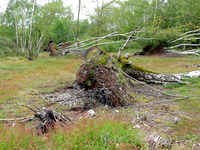
General description and evaluation of ecology
Compartment 6 contains a variety of habitats. Subcompartment 6A, which covers the bulk of the area, includes some quite sizable areas of restored heathland bordered by secondary woodland and scrub. There are some fine mature specimens of oak and birch, notably on the common boundary to the south and parcels of mature oak coppice elsewhere. A small wet flush with willow and sphagnum, dense stands of gorse and small areas of both neutral and acid grassland provide a variety of botanical interest and habitat elsewhere. A number of the wider paths and tracks create excellent conditions for butterflies and a warm sheltered microclimate for other invertebrates, for which there are many nectar sources available including bramble, gorse, broom, hawthorn and heathers. Notable vascular plants present include wild daffodil, an ancient woodland indicator, on the far west of the compartment and common spotted orchid on the area of rabbit-grazed neutral grassland in the north east corner. Typical bird species here include Dartford warbler, nightjar, chiffchaff, woodlark and blackcap. There is good potential for improving this compartment to benefit typical heathland species whilst not detrimentally affecting those birds (e.g. nightingale) that rely on fairly dense thickets of scrub, small trees and mature woodland. This would also benefit several of the reptile species present on this site, notably adder, common lizard and slow worm.
Sub-compartment 6B is known as Thornford Gully. As the name suggests this is an alder gully, fairly typical of others on the commons although with a higher proportion of oak and birch particularly towards the southern end. Mature alder coppice is underlain by a rich ground flora and a number of different sphagnum species, with an area of willow occupying the head of the valley. Up the valley sides to the east and west the composition changes to oak and birch. A complex system of flushes and pools lead into a small stream which becomes incised as it works its way down to the River Enborne to the south. Notable vascular plants include Solomon's seal (an ancient woodland indicator species). Lower plants are well represented, with several mosses including Atrichum undulatum, Polytrichum formosum, Mnium hornum and a variety of sphagnum species, and the liverwort Pellia epiphylla.
BAP habitats
- Lowland heathland (6A)
- Wet woodland (6B)
Higher Level Stewardship
Options exist for subcompartment 6A.
Overall management objectives
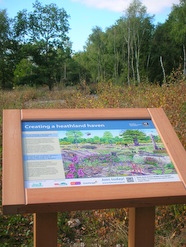
In partnership with BBOWT, between 2010 and 2012 subcompartment 6A underwent approximately 13 ha of tree clearance (25% of woodland maintained within this) as part of a Living Landscape Heathland Restoration Project. (More information is available on BBOWT's web page What we are doing to protect heathland.) The large-scale clearance of birch scrub and young birch woodland extended both existing and relict areas of heath. The compartment retains a wooded perimeter although some open areas were created to link to adjacent habitats on the main common. Small thickets and single trees across the newly cleared areas were left, to provide key woodland edge habitats favouring a variety of species. Woodland edges were scalloped and encouraged to provide thick scrub edges between the heathland and woodland. Large mature and veteran trees have been retained. Gorse scrub has largely been retained but will be managed by coppicing to provide a varied age structure. Thickets of bramble have also been retained to provide habitat for reptiles, small mammals and birds. There has been some limited control of bracken, particularly following tree clearance, but key areas will be retained where they benefit reptiles in particular. Some areas were scraped free of leaf litter and topsoil, to encourage the establishment of heather, some of which has seeded from clippings scattered over the ground.
The overall objective for 6A is to build on this major restoration project, maintaining the open areas as heathland and resisting the natural tendency of reversion to woodland.
Inside and along the path edges of the remaining woodlands, small glades will be created to diversify the structure of the woodland.
For many years one designated area of the compartment sustained an intensive coppice cycle for the manufacture of besom brooms. The broom makers have now retired but in priniple the area remains available for this type of productive activity if someone can be found to carry it out.
The Higher Level Stewardship for the small area of heath incorporates the management of the whole compartment with a Farm Environment Plan submitted in 2010/11. Grazing by Exmoor ponies and cattle may be introduced (to Subcompartment 6A in particular) to create a more varied age structure within the heathland component and to control scrub regeneration following clearance. There has been informal consultation on fencing options to achieve this.
The areas of wet woodland in subcompartment 6B and the existing structure of the woodland, typified by tall mature individuals with a ground layer rich in bryophytes, will be maintained. Wet species-rich flushes will be safeguarded, if necessary removing some scrub where there is evidence that these are drying out. The drier woodland on the upper slopes and higher ground will be retained favouring oak over birch where this is akin to wood pasture. Other individual trees including rowan and veteran birch specimens will be retained.
Water quality, particularly in the Holly Farm area, will be monitored where possible.
Subcompartment 6A (18.6 ha)
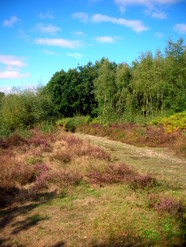
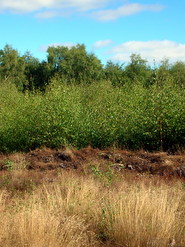
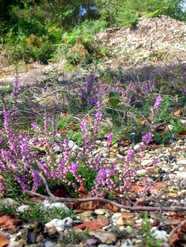
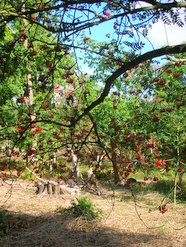
This includes areas of restored heathland, pockets of remnant heath and bracken. Secondary woodland and thick birch scrub, succeeding to woodland, fringes these areas. There are fragments of mature oak coppice elsewhere. There is a small wet flush with willow and sphagnum, some dense stands of gorse and small areas of both neutral and acid grassland.
This area was the subject of a major heathland restoration project in 2010-2012, as part of the The West Berkshire Living Landscape partnership with BBOWT.
| Objective | Area | Method | Comment |
|---|---|---|---|
6A.1) Maintain existing heathland.HLS objective |
Extant areas of heath both restored and relict throughout subcompartment 6A. |
Mow heath in small strips over a 25 year rotation. (Up to 5% of heath area each year, preferably in short, thin, sinuous shapes. Collect and remove cuttings and deposit on site in suitable woodland edge. Create small scrapes (1% of heath) for bare ground/gravel and pioneer heather regeneration. Control bracken, willow, birch, gorse scrub and brambles by mowing or cutting, using herbicide if required (weed-wiping is an option). Where Bracken has dominated, the litter can be scraped to encourage new heather growth and bare ground.
Control bracken on existing and restored heath to prevent dominance, permit bracken in the woodland edges. Treat bracken as permitted by herbicide regulations. Follow up with removing bracken litter in following year. Cut bracken to reduce its vigour at woodland edges if relict heathland flora exists beneath. Spray bracken where it occurs more than 25 m from woodland edges. Scrape selected areas following treatment of bracken (autumn/winter) and push up into banks. Retain a proportion of bracken in key areas to benefit reptiles in particular. Remove birch and treat stumps. Maintain small clumps of birch and single mature trees in open heath for cover and perches. Also, maintain a thick boundary of scrub where heath meets the woodland and cut small sections of this each year. |
Screen main paths from open heath.
An important area for reptiles. See Report for Reptiles (d'Ayala 2012). |
6A.2) Increase area of heathlandHLS objective |
Expanding from and linking existing areas of heath throughout subcompartment 6A. | Fell secondary woodland, particularly where relict heath flora exists, to extend area of heath. Stumps should be treated, and litter scraped in small sections to expose seed bank (or re-seeded by scattering clippings from existing stock). Scallop edges to increase the length of the woodland/heathland boundary. Control brambles and bracken. | A significant percentage of thick scrub and brambles should be retained for nightingales. |
| 6A.3) Create a more diverse, structured woodland. | All woodland within 6A. | Clear small glades (0.1 to 0.25 ha) by felling birch. Stack logs. Burn or stack brash where suitable and leave stumps to regenerate. Leave standing deadwood where safe. Retain fallen deadwood in situ except where it blocks marked paths. Generally favour regenerating native species other than birch, protect oak and rowan saplings where necessary by dead hedging. In the small wet gully in the southeast corner, favour willow over birch. |
Stacked logs form habitat piles for reptiles, invertebrates etc. |
| 6A.4) Maintain wide rides. | All main paths and tracks. | Cut back encroaching gorse and bramble from paths annually to provide appropriate clearance along paths and tracks. | Benefits for visitors, and wide rides are good for butterflies and reptiles in particular. Will link in with bays/scalloped edges and open areas to create wildlife 'corridors'. |
| 6A.5) Protect woodbank. | Southern boundary of compartment. | Refer to Historic Environment Management Plan for further guidance. Seek advice from WBC Archaeology team. |
Historical Environment Survey and Management Plan (BAS 2011) |
Subcompartment 6B (3.9 ha)
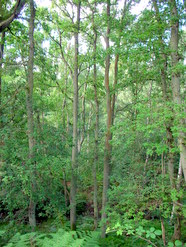

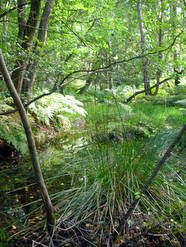
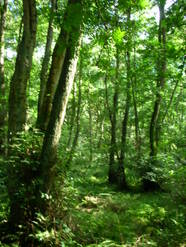
This is a wet gully, draining southwards toward the River Enborne, with alder in the valley bottom grading to oak and then birch further up the valleys sides.
| Objective | Area | Method | Comment |
|---|---|---|---|
| 6B.1) Maintain woodland as high forest with minimal intervention. | Alder woodland on valley floor and lower slopes. Oak woodland on upper slopes of gully - east, west and north. |
Non-intervention in the bulk of the woodland to allow it to move towards ‘high forest’.
Retain any standing and fallen dead wood as habitat for invertebrates, fungi, bryophytes and vascular plants. Encourage oak regeneration when gaps occur in the canopy naturally - locate any oak seedlings and saplings and protect (e.g. dead hedge) to protect from browsing and grazing. Limit birch regeneration by clearing 10% of birch scrub in this part of the subcompartment annually. Do not treat stumps. |
Ensure any management is sympathetic to requirements of bryophytes. Refer to Bryophyte and Lichen Site Dossier (NatureBureau 2009). |
| 6B.2) Protect woodbank. | Southern boundary of compartment. | Refer to Historic Environment Management Plan for further guidance.
Seek advice from WBC Archaeology team. |
Historical Environment Survey and Management Plan (BAS 2011) |